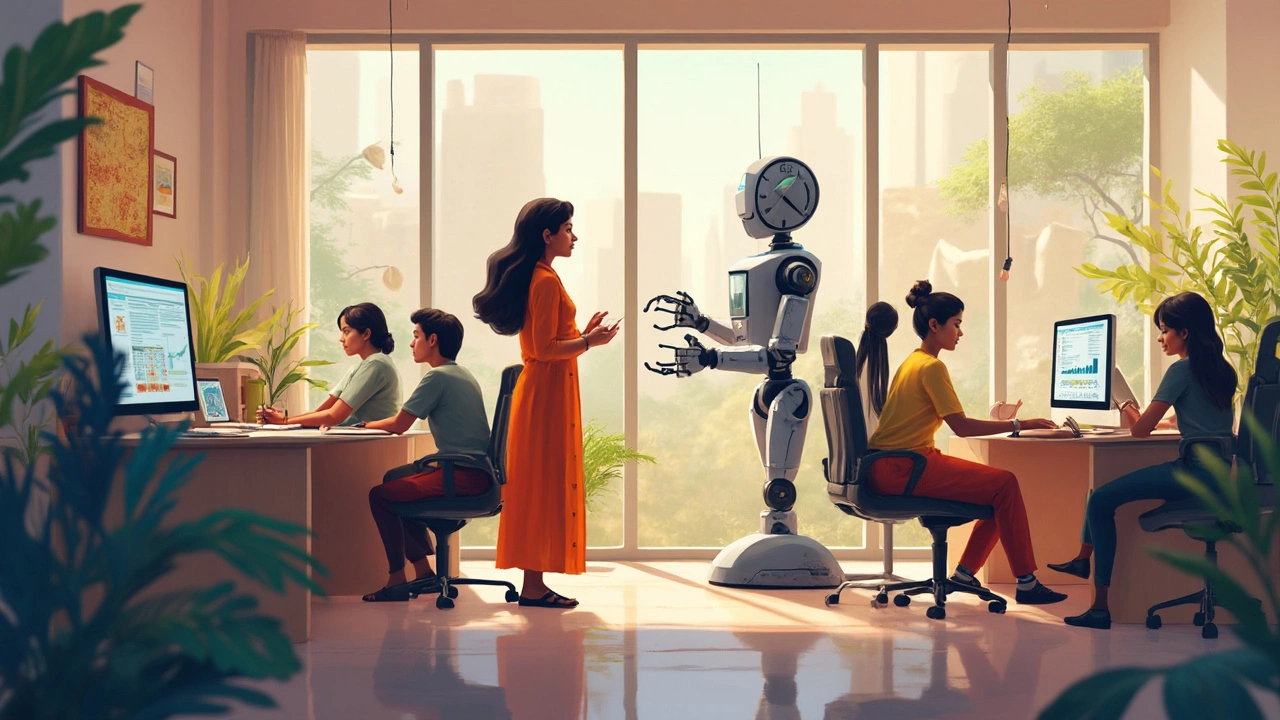Jobs in Danger from AI: What Roles Are Most at Risk?
 Apr, 22 2025
Apr, 22 2025
Ever wondered if robots will take over your job? You're not alone. More and more office workers are nervous about being replaced by artificial intelligence. A 2024 LinkedIn survey found that nearly half of employees in data entry and customer support feel their roles could vanish by 2026. It's not just hype—AI tools are already writing emails, reviewing contracts, and even designing graphics at lightning speed. If a task is repetitive or follows clear rules, there's a good chance a smart algorithm can handle it.
But it’s not all doom and gloom. Knowing which jobs are most at risk gives you a head start to adjust, learn new skills, or even pivot careers. If you spend most days crunching numbers, filling out forms, or typing the same responses to customer questions, it’s smart to think about your Plan B. On the other hand, if your work needs creative problem-solving, people skills, or messy real-world awareness, you’ve got a fighting chance against the bots.
- The Fastest-Affected Jobs
- Why Do These Jobs Face Automation?
- Jobs That AI Struggles to Replace
- How to Protect Your Career
- Real-World Stories and Surprising Shifts
The Fastest-Affected Jobs
If your work is mostly plugging stuff into spreadsheets, sorting files, or answering the same questions all day, your job may be in real trouble from AI impact and automation. Let’s break down the roles facing the chopping block the soonest—think months or just a couple of years, not decades.
- Data Entry Clerks: The days of manually updating databases and typing out forms are fading fast. AI tools can zap through thousands of forms in seconds, and companies love it – it's cheap and perfect for zero-mistake results.
- Customer Service Reps: Have you noticed chatbots popping up everywhere? By 2024, over 60% of basic customer questions were already answered by AI, like order tracking or account changes. Some big companies cut whole call centers in favor of always-on bots.
- Translators and Interpreters: Apps like DeepL and Google Translate are way better now. For basic stuff, companies often skip hiring a person and let AI handle it, especially in global business emails.
- Simple Bookkeeping and Payroll: Software like QuickBooks and Xero can process payroll, balance sheets, and invoices in minutes with barely any human help.
- Basic Graphic Designers: Canva, Adobe’s AI tools, and DALL-E are churning out flyers and logos even for small businesses who never paid designers before. If your design work is mostly cookie-cutter, AI has you covered.
Check out how fast this shift is happening:
| Job Category | % of Tasks Automated by AI (2024) |
|---|---|
| Data Entry | 75% |
| Customer Support | 60% |
| Translation | 55% |
| Payroll/Bookkeeping | 50% |
| Basic Graphic Design | 40% |
If you or your friends are in any of these roles, it’s smart to keep an eye on new technology and maybe start learning skills robots just can’t master yet—like critical thinking or creative problem solving. These are the jobs artificial intelligence targets first—and companies are moving quickly.
Why Do These Jobs Face Automation?
Most jobs facing the axe from AI impact have two things in common: they follow a clear set of rules, and they involve repeating the same type of work over and over. Think about data entry. You’re copying info from one place to another—nothing unpredictable. That’s exactly what software like Robotic Process Automation (RPA) does fast and cheap, without coffee breaks.
If a job can be written up as a step-by-step list, AI and automation can usually copy it. For example, customer service chatbots answer common questions by scanning a knowledge base, just like a human would. Software tools now handle these requests 24/7, without ever calling in sick.
Here are a few big reasons these jobs are easy targets for automation:
- Predictable tasks: Most affected roles don’t need creative thinking—if the computer knows what to expect, it can do the work.
- Lots of data: AI gets better with more examples. Jobs dealing with big sets of numbers or records (accounting, inventory, logistics) are easy for algorithms to handle.
- High volume: Repetitive work on a large scale (like scanning invoices or answering IT tickets) is ideal for fast, tireless machines.
- Text and language tasks: Tools like ChatGPT and Google’s Gemini can now write emails, summarize reports, and even generate legal documents faster than many humans.
Check out this simple breakdown showing how much of a job can be automated, based on tasks being routine or complex:
| Job Type | Routine Tasks (%) | Automation Potential (%) |
|---|---|---|
| Data Entry Clerk | 95 | 85 |
| Customer Service Agent | 80 | 75 |
| Paralegal | 70 | 60 |
| Creative Marketer | 30 | 15 |
So, when you hear about the next wave of job loss in banking, insurance, or retail, remember: it’s usually the jobs that don’t reward thinking outside the box that feel the heat first.

Jobs That AI Struggles to Replace
Not every job has a target on its back when it comes to artificial intelligence. Some roles need a level of human interaction, creativity, or quick thinking that machines just can’t copy. Let's break down the jobs where humans still come out on top.
First, caring professions like nurses, therapists, and social workers are mostly safe. AI can’t replace the empathy or gut feeling needed to help someone through a tough day or a medical emergency. Even with the fanciest chatbot, nobody wants therapy from a laptop screen alone.
Next, think about skilled trades. Plumbers, electricians, auto mechanics—they fix problems that aren’t always the same twice. Crawl under a sink or diagnose a weird knocking sound in a car? That’s a safe zone, at least for now. AI robots would need to handle the unpredictability of real life, and we're not there yet.
Creative jobs are another tough nut for AI. Writers (yes, even with ChatGPT in the game), filmmakers, designers, and chefs create new trends, shapes, flavors, or stories. AI can suggest ideas or copy old ones, but it doesn’t know how to invent a new viral recipe or tell a joke that actually lands.
- Teachers and childcare providers: kids need human connection to learn and grow.
- Professional negotiators, salespeople, and mediators: reading between the lines in a heated conversation isn’t easy for a bot.
- Leadership roles: managing tough teams or making high-stakes decisions needs a human touch.
It’s not just a gut feeling—according to a 2024 MIT study, jobs relying on unpredictable environments or human judgment are still way out of reach for AI impact and automation. Here’s a quick look at how safe some jobs are right now:
| Job Type | AI Replacement Risk (2025) |
|---|---|
| Nurse | Very Low |
| Plumber | Very Low |
| Teacher | Low |
| Graphic Designer | Medium |
| Factory Assembler | High |
If your work lives in the unpredictable real world, needs a personal touch, or calls on your creativity, you’re in a solid spot. That said, keeping your skills fresh and embracing what tech can’t do is still the best game plan.
How to Protect Your Career
If you keep hearing about AI impact and job loss in the news, don’t just worry—do something about it. The good news is, there’s plenty you can do to make yourself stand out from the crowd and stay ahead of the automation wave.
For starters, work on skills that machines aren’t that great at. Think complex problem-solving, creativity, teamwork, leadership, emotional intelligence, and anything customer-facing. AI can process a billion numbers in seconds, but it can’t motivate a team or come up with a comic relief idea for a tough client meeting.
Upgrading your tech skills never hurts. A 2023 PwC report said that workers who regularly upskilled were 15% less likely to be replaced by automation. Learning how to use the latest AI tools (instead of ignoring them) gives you an edge. For example, marketing pros who play around with AI-driven analytics aren’t just safe—they’re more valuable.
- Take online courses in skills like data analysis, coding basics, or digital marketing.
- Hone people skills—think communication, negotiation, and mentorship. These are hard for AI to mimic.
- Mix up your routine at work. If you only handle repetitive work, ask to take on projects with more problem-solving or teamwork elements.
- Follow the trends. Subscribe to newsletters or podcasts on artificial intelligence or automation so you’re the first to spot shifts in your industry.
- Don’t be afraid to job-hop into sectors that are safer from AI, like healthcare, skilled trades, creative roles, or tech management.
Check out this quick comparison of which skills help you dodge automation versus the ones machines already do better:
| Safe from AI | At Risk from AI |
|---|---|
| Problem-solving | Routine data entry |
| Interpersonal skills | Standard customer support chats |
| Creativity & design thinking | Simple financial forecasting |
| Project management | Scheduling and basic admin |
At the end of the day, jobs will change, but people who learn and adapt will have a big advantage. Being curious and proactive is your best shield against getting replaced.

Real-World Stories and Surprising Shifts
It’s one thing to hear that artificial intelligence is rewriting the workplace, but seeing how it’s already happening hits differently. Take copywriting at ad agencies. In 2023, an agency in Mumbai swapped out junior copywriters for an AI writing tool, using it to draft social media posts, email subject lines, and quick ad slogans. The agency’s creative director said productivity jumped by 60%. That meant fewer entry-level jobs and more pressure on remaining employees to focus on bigger, strategy-driven tasks.
Call centers are another ground zero for the AI impact. A well-known US telecom company rolled out an AI-powered chatbot in early 2024. Within three months, the bot was handling almost 70% of simple customer requests—stuff like checking data balances, updating addresses, or ending subscriptions. Human agents now mostly take the trickier calls. The company did retrain some staff to manage the tech, but about 25% of jobs disappeared, according to a detailed HR report shared last fall.
Retail saw some wild changes, too. Amazon Fresh stores started using smart checkout systems in 2022. You scan your phone going in, fill your bag, and just leave—no cashier needed. By mid-2023, industry data showed that cashier roles in test markets dropped by about 30%. That’s not just a guess; retail labor statistics out of Seattle back it up.
On the flip side, some companies find new roles instead of just cutting jobs. A big international insurer used to employ dozens for claim form reviews. After automating with AI, they bumped some workers up to fraud prevention teams, which actually get trickier as the algorithms get smarter.
If you’re worried, take a look at what these workplaces have done to weather the change:
- Staff upskilling: Companies teaching digital and tech skills to make workers more valuable.
- Hybrid human-AI teams: Employees overseeing and editing work generated by AI, especially in areas like finance and customer support.
- Moving into relationship-based roles: More employees getting involved in jobs needing empathy and judgment, which automation still can’t handle well.
The takeaway? AI is real and it’s here, but jobs aren’t vanishing overnight. The smartest people—and companies—find ways to shift, not just shrink.